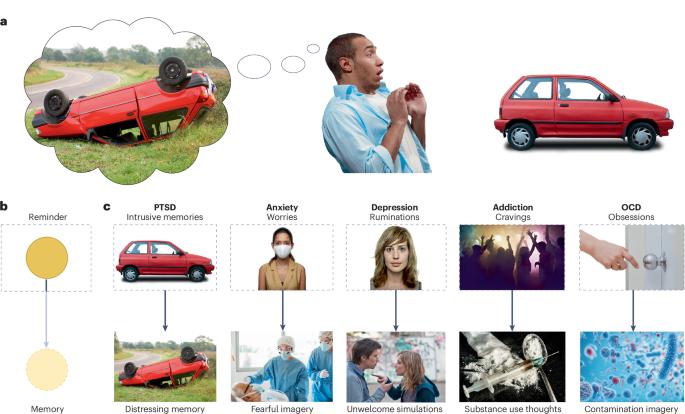思维抑制控制背后的大脑机制
IF 26.7
1区 医学
Q1 NEUROSCIENCES
引用次数: 0
摘要
控制行动和思想需要停止心理过程的能力。在过去的二十年中,越来越多的证据表明,由右侧前额叶皮层支持的域一般抑制控制机制实现了这些功能。然而,目前对抑制控制的神经机制的看法主要来自于对动作停止的研究。虽然行动停止是一个方便的经验模型,但它不会引起思想抑制,也不能用于识别这一过程的独特特征。在这里,我们回顾了有关生物体如何停止驱动思想的关键过程的研究:记忆检索。这项工作表明,检索停止与动作停止共享右背外侧和腹外侧前额叶机制,与域一般抑制控制机制一致,但也需要一个独特的额颞通道来决定精神控制的成功。作为这一途径的一部分,海马体内gaba能抑制会影响前额叶控制思维的效果。这些独特的精神控制因素表明,海马体去抑制是侵入性思维的一个跨诊断因素,将额颞叶控制途径与精神疾病和恐惧消退的临床前模型联系起来。我们认为,在许多精神疾病中普遍存在的侵入性思维可能是检索停止缺陷的基础。本文章由计算机程序翻译,如有差异,请以英文原文为准。


Brain mechanisms underlying the inhibitory control of thought
Controlling action and thought requires the capacity to stop mental processes. Over the past two decades, evidence has grown that a domain-general inhibitory control mechanism supported by the right lateral prefrontal cortex achieves these functions. However, current views of the neural mechanisms of inhibitory control derive largely from research into the stopping of action. Whereas action stopping is a convenient empirical model, it does not invoke thought inhibition and cannot be used to identify the unique features of this process. Here, we review research that addresses how organisms stop a key process that drives thoughts: memory retrieval. This work has shown that retrieval stopping shares right dorsolateral and ventrolateral prefrontal mechanisms with action stopping, consistent with a domain-general inhibitory control mechanism, but also recruits a distinct fronto-temporal pathway that determines the success of mental control. As part of this pathway, GABAergic inhibition within the hippocampus influences the efficacy of prefrontal control over thought. These unique elements of mental control suggest that hippocampal disinhibition is a transdiagnostic factor underlying intrusive thinking, linking the fronto-temporal control pathway to preclinical models of psychiatric disorders and fear extinction. We suggest that retrieval-stopping deficits may underlie the intrusive thinking that is common across many psychiatric disorders. The capacity to prevent unwanted thoughts is important for cognitive function and mental health. Anderson et al. describe insights into the neural mechanisms of the inhibitory control of thought that have been gained from studies of retrieval stopping and discuss how this knowledge informs our understanding of psychiatric disorders associated with intrusive thinking.
求助全文
通过发布文献求助,成功后即可免费获取论文全文。
去求助
来源期刊

Nature Reviews Neuroscience
NEUROSCIENCES-
自引率
0.60%
发文量
104
期刊介绍:
Nature Reviews Neuroscience is a multidisciplinary journal that covers various fields within neuroscience, aiming to offer a comprehensive understanding of the structure and function of the central nervous system. Advances in molecular, developmental, and cognitive neuroscience, facilitated by powerful experimental techniques and theoretical approaches, have made enduring neurobiological questions more accessible. Nature Reviews Neuroscience serves as a reliable and accessible resource, addressing the breadth and depth of modern neuroscience. It acts as an authoritative and engaging reference for scientists interested in all aspects of neuroscience.
 求助内容:
求助内容: 应助结果提醒方式:
应助结果提醒方式:


